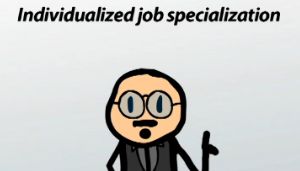Mechanistic & Organic Organizational Business Structures - Answers
The answers are in BOLD below.
NOTE: The transcript from the video is listed below the quiz for your reference.
1. Which of these organizational structures is used in organizations that face unstable and dynamic environments and need to quickly adapt to change?
- mechanistic
- organic
- hierarchal
- flat
- formalized
2. Which of these organizational structures is based on a formal, centralized network and is best suited for companies that operate in a stable and certain environment?
- organic
- hierarchal
- flat
- formalized
- mechanistic
3. Which of these organizational structures awards power and authority to lower-leveled employees?
- organic
- mechanistic
- hierarchal
- flat
- formalized
4. Which of these organizational structures has a well-defined hierarchy where top-level managers make most of the decisions?
- organic
- hierarchal
- flat
- mechanistic
-
formalized
5. In which of these organizational structures are functional areas highly integrated and dependent on each other?
- mechanistic
- organic
- hierarchal
- flat
- formalized
Different organizations require different structures. This lesson describes the differences between mechanic and organic organizational structures by looking at the specifics of organizations.
Organizational Structure
The organizational structure refers to the type of framework a company uses to distinguish power and authority, roles and responsibilities, and the manner in which information flows through the organization. An organization must choose a structure that is appropriate for its individual needs and allows for the company to react and adapt to uncertainties and changes in the internal and external environments. Having a suitable organizational structure will allow a company to implement proper operating procedures and decision-making processes that will aid the organization in accomplishing its goals. Tom Burns and G. M. Stalker identified two basic forms of organizational structure: mechanistic and organic structures. This lesson describes the differences between the two types of organizational structures.
 |
Mechanistic Structure
A mechanistic structure, also known as a bureaucratic structure, describes an organizational structure that is based on a formal, centralized network. The mechanistic structure is best suited for companies that operate in a stable and certain environment. In general, a mechanistic structure is easy to maintain and rarely needs to be changed when an organization operates in a stable environment.
In mechanistic organizations, authority reflects a well-defined hierarchy where top-level managers make the majority of the decisions. Because the environment is relatively stable, complex decision-making processes that involve multiple parties are not required. Subordinates are expected to follow the directions of management and not question their rationale. Communication, much like decisions, also flows through hierarchical routes, or from the top down.
Individualized job specialization is used to place employees into designated tasks. In mechanistic organizations, it is typical for each person to be assigned one task that is relatively stable and easy to control. As a result of the stability of tasks, there tends to be low integration between functional areas or departments in organizations that use a mechanistic structure. Likewise, this creates a situation where, for the most part, functional areas are not dependent on each other.
 |
 |
Organic Structure
Organic structures are used in organizations that face unstable and dynamic environments and need to quickly adapt to change. When an environment changes, an organization must be able to gather, process, and disseminate information very quickly. Failure to do so can directly affect an organization's ability to maintain its competitive advantage. Communication is lateral and rapid in these complex environments. To achieve this, organizations that use an organic structure will integrate functional areas and departments together so that information can flow seamlessly between them. This fast distribution of knowledge results in an increased ability to respond to changes in the internal and external environments.
Needs can change quickly in an organic organization, making it necessary to continually redefine tasks that allow each person to be responsible for multiple tasks at a time. Organic organizations also practice joint specialization, whereby employees work together and coordinate tasks of a larger project often in the form of teams. Having a broad understanding of how multiple tasks work together allows each individual to respond quickly to change.
Decision-making in organic structures is decentralized, allowing for more complex decision-making processes involving multiple parties at all levels of the organization. The uncertainty of organic organizations makes it virtually impossible and almost counterproductive to institute standardized processes and procedures. Therefore, power and authority should also be delegated to lower-leveled employees.
 |
Lesson Summary
Let's review. The organizational structure refers to the type of framework a company uses to distinguish power and authority, roles and responsibilities, and the manner in which information flows through the organization. There are two basic forms of organizational structure: mechanistic and organic structures.
A mechanistic structure, also known as a bureaucratic structure, describes an organizational structure that is based on a formal, centralized network. The mechanistic structure is best suited for companies that operate in a stable and certain environment. Characteristics of mechanistic structures include:
- Horizontal communication
- Well-defined hierarchy
- Top-level managers make the majority of decisions
- Individualized job specialization
- Low integration between functional areas or departments
Organic structures are used in organizations that face unstable and dynamic environments and need to quickly adapt to change. Characteristics of organic structures include:
- Lateral communication
- Highly integrated and dependent functional areas
- Do not rely on standardized processes and procedures
- Multiple tasks are differentiated to one person
- Decision-making is decentralized to allow for complex decision-making processes
- Power and authority are awarded to lower-leveled employees